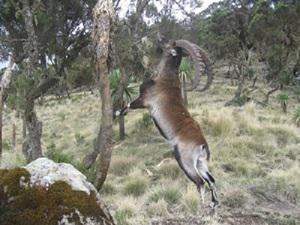Berihun Gebremedhin Mewicha
This project will assess suitable habitat of one of the most endangered endemic Ethiopian mammals, the Walia ibex. Habitat suitability models will be used to identify, analyse, and evaluate the major areas for future establishment of new populations outside of the current range. The main objective is to generate data which are relevant to conservation and management of the Walia ibex with emphasis on future recovery of the population using the reintroduction approach.

This study is part of my PhD project - Non-invasive tracking of the last remaining Walia ibex– an endangered endemic mammal of Ethiopia, which attempts to understand the ecology and conservation genetics of the Walia ibex. The project in its broad objective will address key ecological and population genetic issues such as population estimates, relatedness, home ranges, feeding habit and competition among Walia ibex and other mountain ungulates and domestic livestock. The current distribution ranges of the Walia ibex in the Simen Mountains National Park is too small and confined only to the mountainous areas. Official report indicates that the population size is slightly increasing in the last one decade. There are concerns that the current habitat ranges could be insufficient to sustain viable populations in the future, and high human population density and settlement in the mountains would hamper the natural expansion of the Walia ibex. Given the present status of the species and its refugee, reintroduction of certain individuals would be recommended as remedy to ensure future survival of the species. Information on the availability of suitable habitat derived from this study will provide benefit for sustaining reliable populations and ensure both long-term persistence and evolutionary potential.

The expansion of a recovering population is shaped by biological factors such as the land tenure system or dispersal, the distribution and availability of resources, habitat and landscape features, and human attitudes and activities. Full understanding on these factors and prediction on potential distribution is required to develop efficient conservation and recovery strategies. Long before reduced to its present number and narrow distribution range, the Walia ibex might have had wider distribution over suitable habitat in Simen Mountains. Many of the species’ previous ranges are no longer harbouring it, and the mammal have been seriously threatened and included in the IUCN red list as critically endangered. Currently most of the remaining animals are found within the boundaries of the SMNP. The success of reintroduction programs of endangered species often depends on the ability to identify suitable habitat within the species’ former range. This study primarily aims to develop a habitat suitability map of walia ibex from a number of different environmental factors including land cover types (forest, bush land, erica, agriculture, human settlement and grassland), elevation and slope. The work is expected to come up with appropriate recommendations and strategies for the conservation of the species.